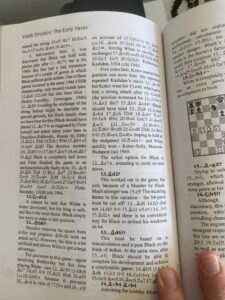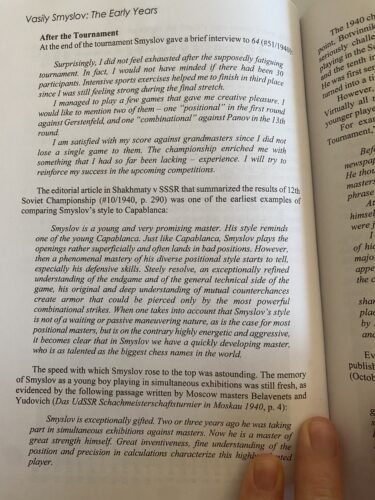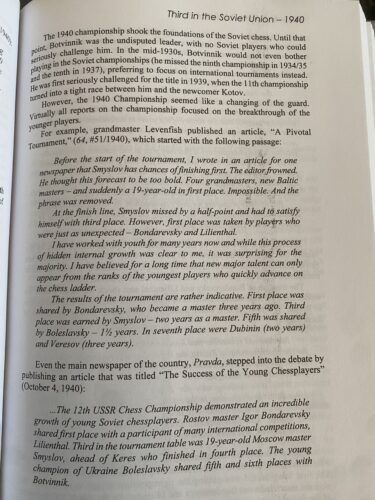Disclaimer 1: The following article contains several affiliate links to Amazon.com, meaning that if you go to Amazon and buy the recommended product (or some other product in an allotted period of time), the author of these lines will get a commission % from the purchase
Disclaimer 2: The following article is an excerpt from my article titled Best Chess Books 2022 in which I reviewed 20 chess books
Andrey Terekhov: The Life And Games Of Vasily Smyslov, Volume I, The Early Years, 1921-1948
What is the book about?
As the title suggests, the book is devoted to the earlier, arguably lesser-known, part of Vasily Smyslov’s career, covering the 1921-1948 period over the course of 10 separate chapters. Every chapter is split into two parts, the first one covering the events and telling the story and the second one featuring Smyslov’s games from the given period. The book concludes with a special chapter about Nadezda Andreevna (Smyslov’s wife) and even features two specialized chapters – one about Smyslov’s System in the Grünfeld defense, and one about Smyslov’s Endgames (specially prepared by a renowned endgame specialist Karsten Müller).
Why do I love this book?
I first got acquainted with the name of the Russian Fide Master, ICCF International Master, and owner of the Ph.D. in Computer Science, Andrey Terekhov, on Twitter, when someone shared an article he wrote for chess 24 about the early years of Vasily Smyslov.
I was thoroughly impressed by all aspects of the article, but especially with the amount of research that was poured into the article, evident from the abundance of historical resources referenced throughout the article. When I realized this article is only an excerpt and that Andrey is writing a full book devoted to Smyslov’s Life and Games, I was immediately excited. When the first part, titled The Life and Games Of Vasily Smyslov, Volume I, The Early Years, 1921-1948 came out, it was, thus, a no-brainer for me to purchase it. 1
In my mind, this book sets a gold standard when it comes to chess historical/biographical books. The amount of research and historical references is almost unprecedented. Almost on every other page, there are quotes taken from old magazines 2, newspapers, and other books and publications. Just like in his articles, Andrey Terekhov doesn’t make any claim without substantiation and one can only imagine how much time and effort was put into the research and compilation of all these historical sources.
On the other hand, despite the abundance of historical sources, the book is not dry or boring to read by any means. Just like in his articles, Andrey manages to weave the historic data with his masterful writing and storytelling to create a very compelling, interesting, and not-too-difficult-to-read narrative.
To be fair, the fact that the entire 1921-1948 era is extremely interesting not only from the chess perspective but from a general historical perspective, probably didn’t hurt. Maybe it is just me, but I can never read enough stories from these old Soviet times – especially if they are connected to chess. I find learning that Smyslov was a big celebrity who had genuine „groupies“ from whom he received regular letters, realizing that he was a part of the aviation squad during World War II, or just reading about chess life in the Soviet era in 1940-1945 endlessly fascinating.
As for the chess aspect of the book, it is also of very high quality. The games are carefully selected and thoroughly annotated, with a lot of annotations and meaningful textual explanations. True, the author does heavily rely on the engine 3 and there are certain instances where the engine analysis is prevalent and may be overly prolonged, but these instances are few and far between.
Now, the aspect I didn’t like as much as the very decision to split the chapters into two parts. The problem is that in the first part of the chapter, the author often references key games in the context of a specific tournament – but then they are provided in the second part of the chapter. This means that the reader often has to scroll back and forth between the two parts of the same chapter to connect the game to the specific moment in the specific tournament.
Another aspect of the book that I didn’t find as enjoyable is related to the amount and layout of diagrams provided with each game. Even though the analysis is mostly not that hardcore and prolonged, it is still not possible to read the book entirely without the board. There are even pages where not a single diagram is provided:

Another minor trifle I have with this book 4 are not-so-ideal line breaks, as there are quite a few instances where a sentence/variation starts on one page and ends on another page, making the reading process even more difficult.
But all these issues are not major enough to spoil the overall impression of the book and to overshadow the tremendous effort, research thought, and love that went into the writing of this book.
There is a reason why it got the FIDE Book of the Year 2021 award and why the foreword was written by none other but the legendary Russian Grandmaster Peter Svidler.
I can only wholeheartedly recommend it – especially to those with a marked interest in chess history and Soviet times.






